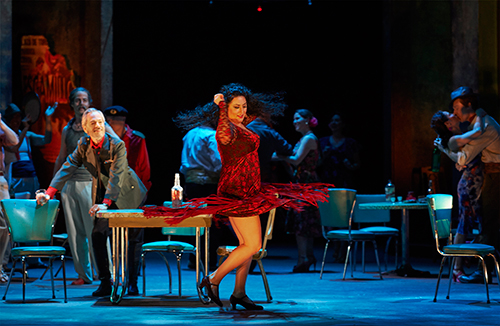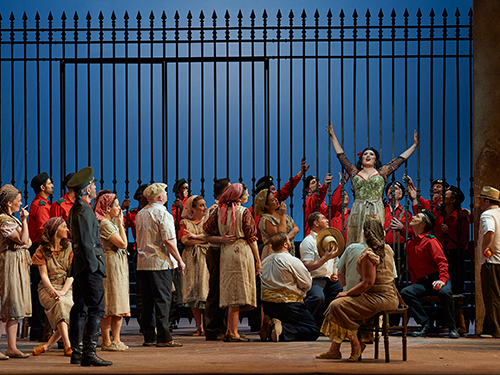-
Love, Sex, Spirit: Bizet’s Enduring Carmen
By COC StaffPosted in Carmen
The greatest opera? Surely it is one of the two or three most popular with audiences and critics alike. Although it notoriously created outrage at its first performance on March 3, 1875 at the Opéra-Comique in Paris, it nevertheless ran for 45 performances that first year. Bizet’s untimely death at the age of 36 on June 3, 1877 cannot therefore be attributed to heartbreak over the opera’s alleged failure. From at least its second performance onward it has gone from success to success, eliciting praise from such luminaries as Wagner and Brahms.
Prosper Merimée (1803-1870) wrote several stories but was more interested in history and architecture. His claim to fame rests on Carmen (1845 –1847), a novella consisting of four short chapters. Yet in structure it forms a curious, broken-backed work.
In chapter one, a self-important archeologist searches in Spain in autumn 1830 for the precise location for the site of one of the world’s greatest battles, at Munda or Monda (el mundo, le monde, the world?), where on March 17, 45 B.C., Julius Caesar defeated the two sons of his dead rival, Pompey. Instead of encountering greatness, the narrator runs into a notorious bandit, Don José Navarro. He forms a bond of friendship with the outlaw by offering him an excellent cigar; later, he helps him evade capture.
Chapter two describes the same narrator’s first encounter with Carmen at twilight in Córdoba just after she has emerged from her bath in the river. The narrator evokes the myth of the goddess Diana bathing and the fate that overtook Acteon for watching her. Or perhaps the attractive young Gypsy typifies Venus/Aphrodite rising from the waves. In turn, he establishes a relationship with Carmen by offering her a cigarette. At her house he runs again into Don José.
It is José who narrates chapter three as he awaits execution for his crimes including three murders (an army officer, Carmen’s husband, and Carmen herself). This chapter supplied most of the material for the opera.
The final chapter has nothing to do with any of this. In it, Merimée himself reflects on the Gypsy life in general, with particular reference to that in Spain. Consequently, Carmen and Don José are seemingly relegated to an illustrative footnote. And yet they embody primal passions and patterns of behavior which raise them to the level of the universal. Merimée delights in such ironic contrasts.
As for Julius Caesar, with whom we began—after his great victory at Monda, which set the seal on the Roman Empire, he probably returned to the arms of his Egyptian “Gypsy,” Cleopatra, before continuing to Rome where he would be assassinated within the year. Perhaps the distance between the high and mighty and a pair of social outcasts is not so great after all.
Much of this superstructure disappears of course in the opera, but the archetypal underpinnings hinted at in the novella are retained and help to generate much of the energy of this extraordinary work. The opera demolishes all sense of distance and a good deal of the irony. Bizet himself suggested the subject and contributed to the libretto, including the all-important words of the “Habanera.” His librettists, Henri Meilhac and Ludovic Halévy, did a masterful job of adapting such an indirect literary work to the direct medium of the operatic stage.
As foils to the two main figures, they created Micaëla (not in the novella) and greatly expanded the role of Escamillo (a minor character called Lucas in the original). Micaëla offsets Carmen by representing all the domestic virtues, a girl who would become a good wife and mother and thus ideal for José in other circumstances. By contrast, Escamillo is the macho womanizer, who temporarily supplants José in Carmen’s affections. Both are static figures but necessary for the action.

“Carmen” is Latin for “song.” And Carmen survives triumphantly for us in the unprecedented sequence of songs or arias which Bizet wrote for her. The “Habanera,” the “Seguedilla,” the Card Scene, and her final encounter with José—all covey her inmost self in a highly concentrated and refined manner. Because, ultimately, Carmen is refined despite appearances to the contrary. She is a woman of great dignity with her own kind of integrity, which often does not match society’s expectations. As a Gypsy, Carmen is a marginalized figure in Spanish society (José is a Basque, another fringe figure). She makes no compromises; she takes no prisoners. A proto-feminist, she expresses in the most memorable and succinct way her own being. She is love, sex, the spirit of untrammeled life and finally of death, embraced like another lover to whom she will, perforce, have to remain true.
And yet for all her colour and charisma as a manifestation of the life-force, Carmen remains essentially the same throughout. She wends her life in a ritual sacrifice, but her end is inherent in her entrance aria. As she proclaims in the refrain, “If I love you, look out.”
To his cost, Don José discovers the truth of this. When she flicks the cassia flower at him, he feels as though he has been struck by a bullet. The wound goes deeper than the flesh, however; he has been stricken to the very soul. All the certainties he had believed in—the honour of a soldier, the prospect of being a good husband and father, the love of his mother—crumble in an instant. Carmen has enslaved him; he is doomed. His desperation follows inevitably and completely; each of the four acts traces a new stage in his tragic fall.
The masterstroke of the entire opera falls precisely where it should: in the final act. In the novella, José stabs Carmen “in a lonely gorge” and buries her in an unmarked grave in a wood, as befits a child of nature. By contrast, the opera ends outside the bullring in Seville. At the exact instant that Escamillo ritually slays the bull, José stabs Carmen. The bull descends from the idea of godhead, and Carmen is linked with the powerful goddesses of classical antiquity. No wonder Nietzsche considered Carmen a Dionysian drama; Greek tragedy is believed to have evolved from Dionysian festivities. Carmen re-enacts those rites.

For non-Spaniards, this opera has come to typify sun-drenched Andalusia, where passions run as high as the temperature. Yet this is not Spain so much as an exotic location, a place of extremes, the homeland of opera. Bizet didn’t consider it necessary to visit Spain. He was writing a French opera, although he did adapt the “Habanera” from Yradier’s “El Arreglito.” Bizet had already set operas in India, Sri Lanka, Russia and Scotland, so Spain must have exercised a comparable allure. What with such components as wild scenery, bullfights and a chorus of girls who smoke and wield knives, it was no surprise that the first audience at the Opéra-Comique in 1875, the home of wholesome family entertainment, was galvanized.
And so we are today. This miracle of a score contains no weak link; infectious melodies and insidious rhythms follow in abundance. And the story has flowered beyond the confines of this one work. Several ballet adaptations and film versions (from Chaplin’s silent burlesque to Carmen Jones and on) have ensured that the basic story of a tragic love has penetrated the modern consciousness. Versions, including hip-hop, proliferate. Stripped of ancient myth which retains its power for every generation, Carmen rules.
Eric Domville is Professor Emeritus of English at the University of Toronto. He lectures and broadcasts on opera, and is a former member of the COC Speakers Bureau. Re-printed with permission from the COC’s 2010 program.
Photo credits - Clémentine Margaine as Carmen and David Pomeroy as Don José in Carmen, (COC 2016); Anita Rachvelishvili as Carmen in Carmen, (COC 2016); Christian Van Horn as Escamillo (centre) and Sasha Djihanian as Frasquita (right, at table) in Carmen, (COC 2016); Anita Rachvelishvili as Carmen in Carmen, (COC 2016), all photos: Michael Cooper.
